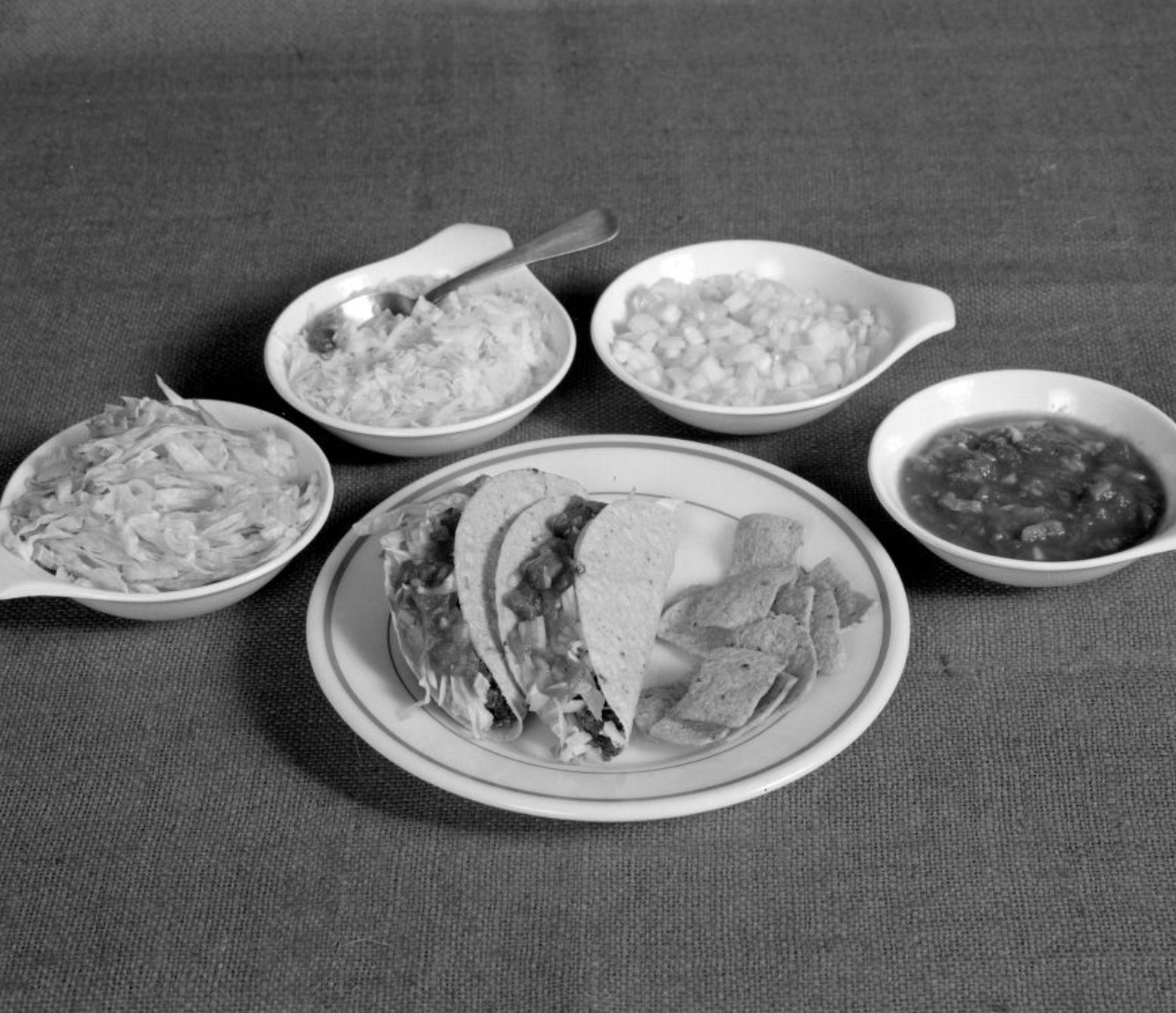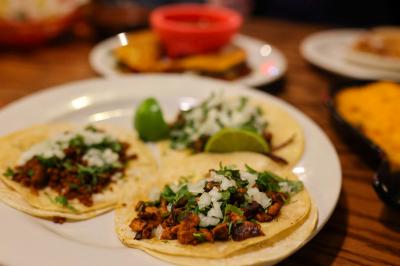Make a Run for the Border: Erie's Evolving Taco Scene
There's a taco for everyone in the Gem City
I didn't eat a taco until I was 12 years old. I'm not proud. In my defense though, there weren't too many places to get tacos where I was growing up in rural Pennsylvania. Most restaurants were still pretty salt-and-pepper and while I'm sure there were some Taco Tuesdays around, beyond the occasional taco salad at a family gathering or whatever that taco pizza was served for school lunches, my taco exposure was minimal.
Around the sixth grade, my older brother's friend introduced me to spicy chicken wings from a local bowling alley. He warned me that the sauce would hurt (and it did), but somehow the pain wasn't bad. This introduction to one of the five basic tastes also broadened what I was willing to eat.
Shortly after, my love of tacos was ignited, perhaps unsurprisingly, at Taco Bell. Having rented Demolition Man on VHS an embarrassing amount of times — a sci-fi action flick set in a future where Taco Bell satirically remains as the only chain restaurant following the Restaurant Wars — this was an easy sell for my first taco. They had also just launched their Fire Sauce packets and, with my taste buds acclimating to heat, I loaded each of my tacos with three packets each… four if I was feeling dangerous. Those Taco Bell trips to nearby Edinboro were soon a weekly occurrence. In the eighth grade, my friends and I even made a documentary titled A History of Taco Bell for our World History class. The teacher gave us a C-plus. They were probably being generous.
In high school, as we began driving and exploring places outside of our small town such as Erie, we soon discovered a whole culinary world previously unknown to us. Our increasingly adventurous taste buds finally had a chance to expand. One of the very first places that we discovered on our own was El Canelo Mexican Restaurant on Peach Street. This was the first place to teach me that tacos could actually have flavor without smothering them with three or four packets of hot sauce.
Of course, I was very late to the taco enthusiast party. Tacos have a long and rich history, both in Mexico and the United States. In their more modern iteration, the origins are not entirely agreed upon. Food historian Jeffrey M. Pilcher is among those who believe that tacos originated with Mexican silver miners during the 1700s. As he described in Smithsonian Magazine, the earliest written reference of tacos he's ever found comes from Mexico nearly a century later. These were called tacos de minero: miner's tacos. In the United States, he believes, the earliest use of the word "taco" in print was 1905.
Many parts of the United States today — California, Nevada, Arizona, New Mexico, Utah, and Colorado — were Mexican territory before the Mexican-American War ended in 1848. The Treaty of Guadalupe Hidalgo transferred over half of Mexico's territory to the United States, leaving Mexican citizens within these territories one year to make a choice: stay, in which they'd become American citizens, or to take their belongings and retreat south of the newly redrawn border. The number of families who stayed is not clear, but what is clear is that the culinary influences of these Mexican American families dominated within these states as Southwest cuisine continuously evolved and fused over the following century.
Tacos were already a working-class staple in Mexico, but their popularity spread a bit slower stateside. In 1947, for instance, the citrus-centric National Orange Show Fair in San Bernardino, California operated its first taco stand on its fairgrounds. Initially, organizers were skeptical of the request. Who wants to walk around holding a taco? As it turned out, a lot of people did. In that first year, the taco stand made over $4,000 — nearly $60,000 today adjusted for inflation.
Still, tacos were not an overnight sensation outside of the Southwest or Mexican American communities. A 1960 Pittsburgh Press report discussing the growing popularity of Mexican food mentioned that there were no Mexican restaurants within the city. Many readers didn't even seem to know what a taco was, leaving reporters the task of explaining them.
"The taco is a sort of sandwich," one Spokane, Washington newspaper said in 1964. "You take a pancake-like tortilla and make a kind of envelope of it. Fill it with meat, lettuce and hot sauce."
It was common throughout the 1960s for tacos to be called "Mexican sandwiches." They were regularly compared to hot dogs and, perhaps rather sacrilegiously, at least once referred to as "a sloppy joe in a tortilla."
"What the pizza and grinder stand is to New England, the taco stand represents on the West Coast," a Connecticut newspaper published. A newspaper in Idaho described a taco as "a tasty morsel with a paper-thin crisp, corn 'pancake' folded around a mixture of chili and beans." It was "easy eating" and "wonderful for munching while reading or watching TV." They suggested replacing ground beef with diced hot dogs for a more "Americanized" version.
After President Richard Nixon and his wife visited a Mexican restaurant in 1970 for their anniversary, a UPI report warned curious readers not to underestimate the spiciness: "A word to the wise: on your first experiment with eating a taco, at home or out, treat the hot sauce with utmost respect. An overdose makes you feel as if you have swallowed a red hot poker."

This 1979 depiction of Americanized tacos shows our country's slow acclimation to the food Mexicans have been enjoying since the 1700s. And while they became popular much earlier in southwestern states, it wasn't until the 1960s that tacos began to gain a foothold in the rest of the U.S. (Photo: Natick Soldier Systems Center Photographic Collection 1979)
In Erie, the Lawrence Hotel opened the Fiesta Lounge in October 1960, hosted by maitre d'hotel Ruben Topete. They offered the first advertised tacos in Erie along with enchiladas, tamales, and tequila. Three years later, Tico's at 1018 Parade St. became the second to advertise tacos. Within a few years, local grocery stores were selling frozen "patio beef tacos" in packages of six for easy home cooking.
A 1964 article in the Erie Daily Times discussing Cinco de Mayo noted that roughly 80 percent of Erieites had never tried a "tasty and tempting" taco. By the 1980s, tacos seemed to be nearly everywhere in Erie, although primarily at non-Mexican owned bars and restaurants. This included the city's first Taco Bell on Peach Street. These bars and restaurants advertised Taco Tuesdays and Taco Thursdays. Rum Runners ran a 25-cent Taco Friday. One bar offered free tacos during happy hour. Even the schools were getting in on the taco craze. In 1989, when McDowell High School's head cook Kay Mullen added chili powder to ground beef for the school's taco day, it actually made local news for becoming an instant student and staff favorite.
When El Canelo opened its first Erie location on West 12th Street in 2001, owner Jose Montes said it was specifically because he viewed "the Erie area as lacking in real Mexican cuisine" and, he stressed, the chain tacos were not his competition. The food, as local food critic Floyd Lawrence wrote, "both looks and tastes more like what you might imagine Mexican food to be than most of the items available at, say, Taco Bell" but also managed to "appeal to the broadest possible spectrum of American tastes."
"Our food is completely different [than Chi-Chi's and Taco Bell]," Montes told the Erie Times-News. "All my people are Mexican. All the cooks, waiters, everybody." By 2003, he and his family had opened their second location on Peach Street in an old Pizza Hut followed by their Harborcreek location a year later. Over the following two decades, well over a dozen Mexican restaurants have opened throughout the city and region offering up their own taco interpretations.
In recent years in the culinary world, there has been a lot of chatter about authenticity in relation to tacos. Like many beloved foods though, what one views as an "authentic" taco varies greatly from Southern California to the many border cities and towns to regionally within Mexico itself. In his book Tacos: Recipes and Provocations, Chef Alex Stupak argues that authenticity is not "fixed and rigid" and Mexican cuisine is a complex "kaleidoscopic blend of indigenous Mesoamerican crops and traditions with the fruits of Spanish colonization."
"Talking about tacos gives us a chance to talk about cultural exchange, about idea appropriation, and about the way we value — or undervalue — ethnic cuisines," he believes, adding that Mexican food deserves the same respect that French cuisine often receives.
José R. Ralat, taco editor for Texas Monthly, deliberately avoids using the word "authentic" when writing about Mexican food and tacos. In his book American Tacos: A History and Guide, he writes about the vast variety of tacos both in Mexico and the United States.
"To put it simply, the evolution of American tacos, like all tacos and beloved dishes, is fueled by regional population shifts, ingredient market availability, and culinary adaptation," Ralat explains. His book covers the usuals, but also Jewish-style tacos, Korean (or K-Mex) tacos, southern Sur-Mex tacos, Alta California tacos, breakfast tacos, fried tacos, barbecue tacos, puffy tacos, chef-driven tacos, and the growing popularity of birria, a style of taco originating in the Mexican state of Jalisco which traditionally utilizes goat meat. With all of his writing about tacos then, what has Ralat learned?
"I've learned that tacos are a gift to be appreciated and enjoyed with friends and strangers," he writes. "No other food in America brings people together like tacos."
Indeed, tacos can tantalize all of your taste buds at once and the balance of flavors — sweet, sour, salty, savory, and bitter — can and should vary from taco to taco and place to place, each with their own unique flavor profile.
The Erie taco scene is no exception. Numerous restaurants across Erie have their own distinct tacos. Eat tacos at a different place every night for a week and, besides being a very happy person, you'll likely have seven very different experiences.
A downtown favorite spot is El Amigo Mexican Grill, operating out of the old Modern Tool building since 2016. Their street tacos, topped simply with onions and cilantro, can be ordered as singles or in threes with freshly made tortillas. Meat choices include asada (lime-marinated beef), al pastor (spit-grilled pork), chorizo (pork sausage), carnitas (slow-cooked pork), and chicken. They also have your staple ground beef tacos with cheese and lettuce as well as birria.
Amigo Taqueria & Botanas in the Millcreek Square describes their recipes as being from their home of Guanajuato, Mexico, northwest of Mexico City. They offer the same proteins as El Amigo with the addition of shrimp and fish tacos, all at comparable prices. Then there is Francisco's Mexican Taqueria which opened in the summer of 2024 on Broad Street and offers all of the previously mentioned proteins on top of two more unique choices: tacos de cabeza (cow's head) and tripas (gut).
Across town at Los Primos Mexican Store & Taqueria on West 26th Street, you can snag some groceries, fresh fruits, and vegetables while picking up some succulent tacos including all of the previously mentioned options plus lengua (beef tongue) tacos. Their condiment buffet is also a sight to see. Two miles east is Casa Café, opened in 2023 by the El Amigo owners, which has plenty of unique offerings including breakfast tacos with chorizo and egg.
Gas station tacos may not be as marketable as street tacos, sure, but Lucky's Mexican Food, locally owned and operated inside the Speed Check at 18th and Parade, has gained quite the loyal following, myself included. For others, the holy grail of local tacos operates seasonally out of a food truck on Poplar Street: El Chona Movil. Trust me when I say that they are worth the trip and navigating the loyal crowd.
Many are eagerly waiting for the city reopening of Enrique's Southeast Mexico Taqueria and Tortilleria, which uses owner Enrique Garcia Frias' mother's recipes, after their building suffered fire damage in 2024. And, if you're lucky, you can catch Julius, operated by former Latino's Restaurant owner Julio Reyes, when they offer up their delicious Mexico City-inspired tacos on their revolving menu.
Plenty of other restaurants, bars, and food trucks have put their unique spins on tacos too. There's the beloved Atacolypse Food Truck, which slings gourmet tacos around town filled with ingredients such as slow-smoked brisket, swordfish, and jackfruit and with names such as Tyler's Tummy Tickler, Irish Shenanigans, Miss Swan, and the Karen.
Lavery Brewery's brewpub has been serving up their own distinct tacos for years too, including more vegetarian options made with tofu and potatoes, while Taco Distro at the entrance of Presque Isle State Park (from those genius gastronomical minds behind Federal Hill Smokehouse) have been offering up tacos with their trademark pickled onions for the past few years. Another recent addition to the local taco game is Bro Man's Birria N' Burger Joint with tacos masterminded by sandwich and burger artist Steve Stanbro who adds quesabirria (braised beef with melty cheese), jerk, and buffalo chicken tacos to the local taco rotation, as well as a vegan option.
Needless to say, there truly is a taco for everyone in Erie and the city's Mexican community has contributed significantly to our local eats scene in recent decades. So, maybe it's time to text that friend you haven't reached out to in a while and say, "Hey, how about some tacos?" The only challenge after that will be deciding where to go.
Jonathan Burdick runs the public history project Rust & Dirt. He can be reached at jburdick@eriereader.com


.png)
